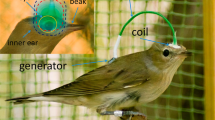Abstract
Magnetic compass orientation in birds is based on light-dependent processes, with magnetoreception being possible only under light containing blue and green wavelengths. To look for possible intensity-dependent effects we tested Australian silvereyes during autumn migration under monochromatic green light (565 nm) produced by light-emitting diodes at various light levels. At intensities of 0.0021 and 0.0075 W/m2, the birds showed normal activity and were oriented in their seasonally appropriate migratory direction. Under low light of 0.0002 W/m2 the birds were less active; scatter increased, but they still oriented in their migratory direction. Under a high light level of 0.0150 W/m2, however, the test birds showed a counterclockwise shift in direction, preferring west-northwest instead of north. This change in behavior may reflect a change in the output of the magnetoreception system, resulting from a disruption of the natural balance between the wavelengths of light.
Similar content being viewed by others
Author information
Authors and Affiliations
Additional information
Received: 18 June 1999 / Accepted in revised form: 20 September 1999
Rights and permissions
About this article
Cite this article
Wiltschko, W., Wiltschko, R. & Munro, U. Light-Dependent Magnetoreception in Birds: Does Directional Information Change with Light Intensity?. Naturwissenschaften 87, 36–40 (2000). https://doi.org/10.1007/s001140050006
Issue Date:
DOI: https://doi.org/10.1007/s001140050006




